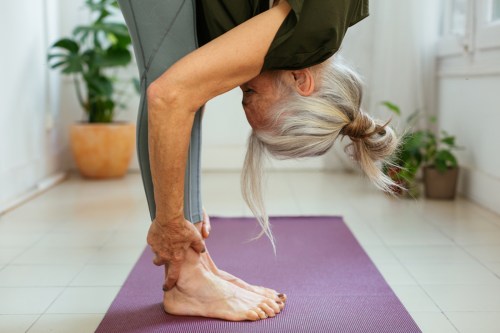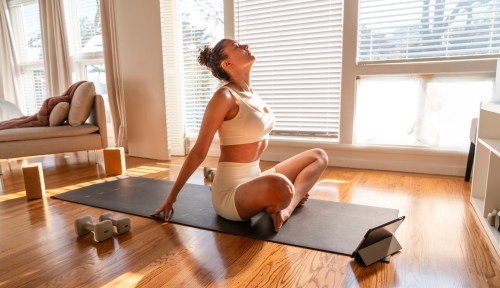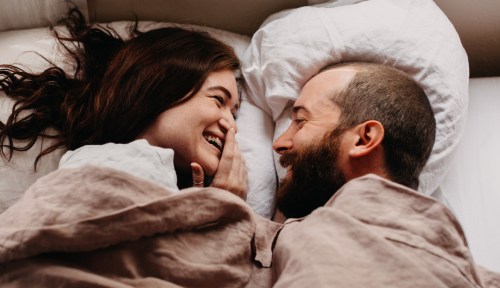For many able-bodied folks, balance can be taken for granted once you grow past the wobbly legs and skinned knees of childhood. But once you hit a certain age, finding balance (literally) isn’t always a given.
Experts in This Article
personal trainer and the American Council on Exercise senior director of science and research
“The main reason many people have balance problems when they get older is because our senses tend to decline as we age,” explains Sabrena Jo, a personal trainer certified in working with seniors and the American Council of Exercise director of research content. Vision (especially perception), the vestibular system (part of the inner ear that works with vision and stops objects blurring when the head moves), and even touch (having a sense of your foot hitting the ground) are all connected to balance. “Strength, reaction time, and coordination can also slightly decline as we age, all of which also affects balance,” she adds.
While these changes are a natural part of the aging process, Jo says there are balance exercises for seniors that can help mitigate these changes. She also says that living an active lifestyle can be a crucial way to prevent balance problems later in life. Movement of all kinds takes balance, she explains. Short walks around the block, playing with your grandkids at the park, and walking the aisles at the grocery store are a few everyday examples of activities that can improve balance.
There are also more specific exercises someone can do with the purpose of improving balance. Here, Jo shares the best balance exercises for seniors, all of which can easily be done at home without any fancy equipment.
6 balance exercises for seniors
1. Standing on one leg
One simple exercise that Jo says can help improve balance is standing on one leg at a time. “This may seem like an obvious one, but it’s really helpful,” Jo says. Stand with your feet together, holding onto a chair or the wall with one hand if needed. Slowly lift your left knee up to bring your foot off the ground. Hold for 30 seconds. Then, put your left foot back on the ground and repeat on the right side.
2. Walk the tightrope
Don’t be intimidated by the name of this move; it’s not the circus act you might be picturing. “Start in a standing position with your feet very close to each other,” Jo says. Then, start to walk forward slowly, placing one foot directly in front of the other. Repeat this move until you’ve walked across all the way across the room (and back, for extra credit).
Jo says this exercise helps with perception. “I also like it because you’re practicing something in a safe space that you will then do out in the world,” she says. “If you do this exercise regularly, it becomes something that’s engrained that your body does without realizing it.”
3. Lunges
“Sometimes someone will bump into you or you’ll step off a curb and you have to regain your balance quickly,” Jo says. “This requires what’s called ‘gait training,’ which is regaining your balance during locomotive activities.” She explains stepping forward or back is typically how balance is regained, which is why lunges can help.
Start by standing with your feet pointing straight ahead, knees straight, and hips facing forward. Your shoulders should be down and back, ears in line with shoulders, and head in a neutral position. Place your hands on your hips. Step forward with one foot. Bend both knees, inhale, and lower the body until your front thigh is parallel to the floor, or until you achieve a range of motion that is comfortable for your body. Your back knee should not touch the floor. To come out of the lunge, exhale and push through your front heel and press with your back foot. Step feet together and return to the standing neutral start position. Repeat with the other foot.
4. Squats
In addition to helping with balance, Jo says squats also help strengthen the lower body and keep joints in the hips and knees flexible. “There’s an important interplay when it comes to strength and flexibility, especially around the joints in the lower part of your body, like your knees and ankles,” she says. “A lot of people lose their balance because they trip over something, but joint flexibility can help with that.”
To do this move, start with your feet hip-width apart, with your arms down by your side. Brace your core, push your butt back and bend your knees (like you’re sitting in a chair). Keep your gaze forward as you lower your body. Then, slowly rise back up to a standing position. Repeat this move for 30 seconds.
Watch the below video to see how to do a squat correctly:
5. Stepping side-to-side
This is another balance move that Jo says is extremely beneficial because it mimics how we move in real life. She recommends moving across the room side-to-side (like a side shuffle) and once you feel comfortable with this move, placing small objects in your path to step over. (She uses small cones and bean bags with her clients.) “You can also walk across the room backwards as well, just to get all the directions in,” she says.
6. Aerobic activities
“One reason people tend to trip or fall is that they have low stamina or endurance,” Jo says. “Being fatigued can lead to coordination problems.” She says aerobic classes and activities (such as walking) can help because they build up cardiovascular stamina. “This is one form of exercise that indirectly helps with balance,” Jo says.
As Jo points out, truly all forms of movement are good for balance, but these are some more specific moves that can greatly help. As you go through them, she advises doing so slowly and not doing anything you aren’t ready for or comfortable with. If you need to start by holding onto a wall or table for balance before moving through the moves holding on to nothing, go for it.
“My other big piece of advice is to watch out for joint pain,” Jo says, which could indicate that your joints aren’t aligned properly or you did too much. (In this case, stop the exercise and seek out a medical professional.) “Last, have fun!” Jo says. “Whatever form of movement and exercises you choose to do should be enjoyable. Find a form of exercise that really speaks to you and go from there.”
Sign Up for Our Daily Newsletter
Get all the latest in wellness, trends, food, fitness, beauty, and more delivered right to your inbox.
Got it, you've been added to our email list.











